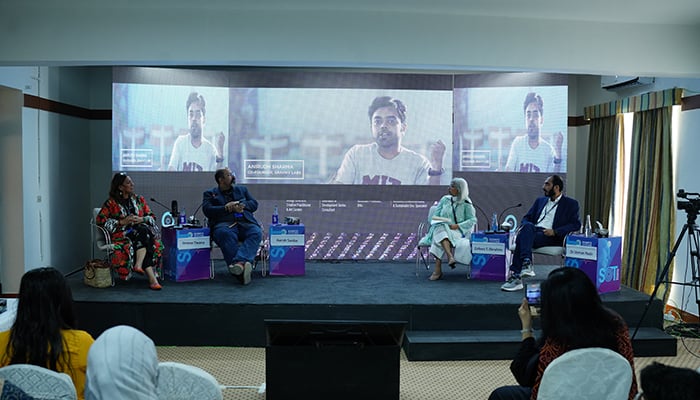
In an era marked by rapid technological progress, humanity faces an unforeseen paradox created by our own innovations. Initially promised as a gateway to a brighter future, these advancements are now edging us towards an uncertain fate.
While countries like Pakistan contribute less than 1% to global carbon emissions, they are among the hardest hit by climate change. This injustice underscored the urgency of the “Sustainability and Reboot Powered by AI” panel discussion hosted by the School of Tomorrow (SOT) and Beaconhouse National University (BNU) at Karachi’s Beach Luxury Hotel.
The panel brought together thought leaders to explore the potential of artificial intelligence (AI) to both save and threaten humanity. Opening with visuals of anticipated climate disasters, the event delivered a stark message: without immediate and strategic action, the impacts of climate change will only worsen.
Double-edged sword of AI: Salvation or undoing?
Environmental activist Imrana Tiwana emphasised the gravity of the situation, quoting John Lennon on humanity’s relentless pursuit of happiness.
“We’ve driven ourselves into an existential conundrum,” she said, highlighting the tension between our advanced capabilities and the looming climate crisis.
Tiwana argued that AI could be a double-edged sword—either the path to salvation or the cause of our undoing. She referenced AI’s astonishing IQ, reportedly at 300 and doubling every 18 months, far surpassing Einstein’s 165, despite AI's relatively limited neural power compared to the human brain.
Technologies and Initiatives Countering Carbon Emissions Environmental journalist Zofeen T. Ebrahim offered a tempered perspective. “At the end of the day, AI is just a tool,” she said, emphasising that, while AI offers unprecedented capabilities, human decision-making remains essential. As powerful as AI is, it lacks the moral compass required for the life-altering choices humanity now faces.
The conversation turned optimistic with Asrish Sardar, who holds an MS in Communication Design from Kingston University London. He shared examples of innovative technologies used to combat carbon emissions, such as “Air-Ink,” a technology that captures pollution and converts it into ink.
Sardar reminded the audience of humanity’s imagination shaping reality, citing the historic "flight to Mars" as a dream realised. “AI isn’t necessarily a threat. It can be a means to an end,” he argued, citing K.I.T., an empathy-driven car, as an example of technology that serves human life rather than threatening it.
“It is now or never,” warned Tiwana. “We can't afford Planet B since Planet A is on the brink of disintegration.” She commended BNU's green campus initiative as a step in the right direction, envisioning it as a model for sustainable infrastructure.
Shaping AI for a sustainable future
Dr Usman Nazir, head of BNU’s AI department, highlighted AI’s potential in data analytics to shape climate strategies. Using AI to analyse respiratory infection hotspots in Lahore, his team has been able to pinpoint areas requiring intervention. “With AI, we can better understand where to focus our efforts,” Dr Nazir explained, emphasising AI’s precision in research and strategic planning.
However, Zofeen reminded the audience of a crucial issue. “If early warning systems exist, why is there so little action?” she asked, citing a recent disaster in Spain as evidence of how early warnings often go unheeded.
In her closing remarks, Tiwana received massive applause with a powerful message. “AI is a double-edged sword; its impact depends on us. We can either use it to confront the future or to shape it for the better,” she said. “It’s up to us to lead AI in a direction that safeguards our beautiful ecosystem.”
As the discussion concluded, one thing was clear: humanity stands at a crossroads. Will we harness technology to repair the damage we’ve done, or allow it to accelerate our downfall? The answer may determine not only the fate of our species but the future of our planet.
















